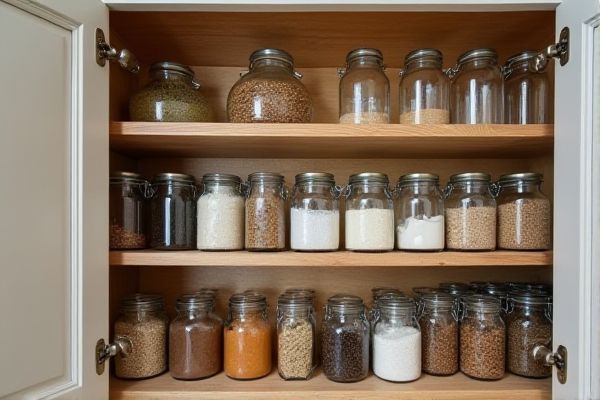
Recycled glass jars offer an eco-friendly alternative to new glass jars by reducing energy consumption and lowering carbon emissions during production, making them ideal for a sustainable pantry. Discover the key differences and how choosing the right jars can impact your storage solutions by reading the rest of this article.
Table of Comparison
| Feature | Recycled Glass Jars | New Glass Jars |
|---|---|---|
| Environmental Impact | Lower carbon footprint; reduces landfill waste | Higher carbon footprint; uses raw materials |
| Durability | Comparable strength; may have minor imperfections | Consistent quality; free of defects |
| Cost | Generally lower cost due to material reuse | Higher cost; raw material and manufacturing expenses |
| Appearance | Slightly varied color and texture | Uniform clarity and finish |
| Food Safety | Meets safety standards after proper cleaning | Guaranteed safety from new production |
| Energy Use in Production | 35-40% less energy compared to new glass | High energy consumption from raw material processing |
| Typical Use | Ideal for eco-friendly pantry storage | Standard pantry storage and commercial use |
Introduction to Glass Jar Storage Solutions
Recycled glass jars offer an eco-friendly and sustainable alternative to new glass jars for pantry storage, reducing environmental impact by minimizing raw material consumption and waste. Both recycled and new glass jars provide airtight seals crucial for preserving the freshness and quality of your pantry items, ensuring long-lasting food safety. Choosing recycled glass jars supports circular economy practices while maintaining the durability and clarity essential for organized and visually appealing kitchen storage.
Environmental Impact: Recycled vs New Glass Jars
Recycled glass jars significantly reduce energy consumption and greenhouse gas emissions compared to new glass jars, as melting recycled glass requires up to 40% less energy. Using recycled glass in your pantry supports waste reduction by diverting glass from landfills and lowering raw material extraction. Choosing recycled glass jars minimizes your environmental footprint while maintaining the same durability and recyclability as new glass containers.
Cost Comparison: Recycled and New Glass Jars
Recycled glass jars typically cost 20-30% less than new glass jars due to lower raw material and manufacturing expenses. The production process for recycled glass requires less energy, resulting in reduced operational costs that translate into more affordable pricing for pantry storage. Mass adoption of recycled glass jars also benefits from economies of scale, further narrowing the price gap with new glass alternatives.
Safety and Hygiene Considerations
Recycled glass jars for pantry use meet strict safety and hygiene standards, as they undergo thorough cleaning and high-temperature sterilization processes to eliminate contaminants and bacteria. New glass jars offer the advantage of being sterile from the outset, reducing the risk of cross-contamination in food storage. Both options comply with FDA regulations for food-grade containers, ensuring safe preservation of pantry items.
Durability and Lifespan
Recycled glass jars and new glass jars both offer strong durability suitable for pantry storage, but new glass jars typically have a more consistent structural integrity due to advanced manufacturing processes. Recycled glass may contain slight imperfections or variations that could affect lifespan, yet it remains a sustainable option with comparable resistance to everyday wear. Your choice impacts long-term performance and environmental footprint, making durability a key factor in selecting pantry containers.
Aesthetics and Design Options
Recycled glass jars often feature unique textures and slight color variations that add a rustic, artisanal charm to pantry displays, making each jar distinct. In contrast, new glass jars offer consistent clarity and sleek designs, allowing for modern and minimalist aesthetics with a wider variety of shapes and sizes. Both options support creative pantry organization, but recycled glass provides a more eco-conscious, handcrafted appearance.
Sourcing and Availability
Recycled glass jars are sourced from post-consumer glass, reducing the demand for raw materials and lowering environmental impact, but their availability can be limited by local recycling infrastructure and collection rates. New glass jars rely on virgin materials like silica sand, soda ash, and limestone, ensuring consistent supply but increasing resource extraction and energy consumption. Choosing recycled glass jars supports sustainability goals while offering comparable functionality, though availability may require adjustments to your procurement strategy.
Practical Uses in Pantry Organization
Recycled glass jars offer an eco-friendly option for pantry organization, maintaining durability and clarity for storing dry goods like grains, nuts, and spices. New glass jars often come with airtight seals and uniform shapes, enhancing stackability and moisture protection in your pantry. Using recycled jars supports sustainability while providing practical storage solutions that keep your pantry neat and organized.
DIY Tips: How to Clean and Prepare Recycled Jars
Thoroughly wash recycled glass jars with warm, soapy water and use a vinegar soak to remove stubborn labels and odors. Scrub lids separately and sterilize jars by boiling them for 10 minutes to ensure pantry safety. Dry jars completely to prevent mold and store airtight for effective reuse in your pantry.
Sustainable Pantry Storage: Which Option Wins?
Recycled glass jars significantly reduce environmental impact by lowering energy consumption and carbon emissions during production compared to new glass jars. Their durability and ability to be reused multiple times make them an economical and eco-friendly choice for sustainable pantry storage. Opting for recycled glass jars supports circular economy practices, minimizes landfill waste, and conserves raw materials for a greener kitchen solution.
 homyna.com
homyna.com